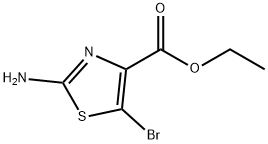2-AMINO-5-BROMO-[1,3,4]THIADIAZOLE
Synonym(s):5-Bromo-[1,3,4]thiadiazol-2-ylamine
- CAS NO.:37566-39-5
- Empirical Formula: C2H2BrN3S
- Molecular Weight: 180.03
- MDL number: MFCD00464325
- EINECS: 231-484-3
- SAFETY DATA SHEET (SDS)
- Update Date: 2023-04-23 13:52:06
![2-AMINO-5-BROMO-[1,3,4]THIADIAZOLE Structural](https://img.chemicalbook.in/CAS/GIF/37566-39-5.gif)
What is 2-AMINO-5-BROMO-[1,3,4]THIADIAZOLE?
Chemical properties
Yellow powder
The Uses of 2-AMINO-5-BROMO-[1,3,4]THIADIAZOLE
2-Amino-5-bromo-1,3,4-thiadiazole can be used:
- As the key building block for the synthesis of myriad of thiadiazolo[3,2-α]pyrimidin-7-ones which have diverse biological activities.
- For the synthesis of 2-bromoimidazo[2,1-b][1,3,4]thiadiazoles by reacting with α-bromo ketones.
Properties of 2-AMINO-5-BROMO-[1,3,4]THIADIAZOLE
| Melting point: | 178-182 °C (dec.) |
| Boiling point: | 314.1±25.0 °C(Predicted) |
| Density | 2.147 |
| storage temp. | Keep in dark place,Sealed in dry,Room Temperature |
| pka | 1.76±0.10(Predicted) |
| color | Beige |
| CAS DataBase Reference | 37566-39-5(CAS DataBase Reference) |
Safety information for 2-AMINO-5-BROMO-[1,3,4]THIADIAZOLE
| Signal word | Warning |
| Pictogram(s) |
 Exclamation Mark Irritant GHS07 |
| GHS Hazard Statements |
H302:Acute toxicity,oral H312:Acute toxicity,dermal H319:Serious eye damage/eye irritation H332:Acute toxicity,inhalation |
| Precautionary Statement Codes |
P280:Wear protective gloves/protective clothing/eye protection/face protection. P305+P351+P338:IF IN EYES: Rinse cautiously with water for several minutes. Remove contact lenses, if present and easy to do. Continuerinsing. |
Computed Descriptors for 2-AMINO-5-BROMO-[1,3,4]THIADIAZOLE
| InChIKey | GLYQQFBHCFPEEU-UHFFFAOYSA-N |
Abamectin manufacturer
Neochemsys Laboratories Pvt Ltd
2Y
Phone:+91-8498007788
Whatsapp: +91- 8498007788
product: 37566-39-5 2-amino-5-bromo-1,2,3-thiadiazole 98%
Dr. Jagath Reddy's Heterocyclics
1Y
Phone:+914023773841
product: 37566-39-5 2-Amino-5-bromo-1,3,4-thiadiazole 98%
Neochemsys
Hyderabad
Phone:91-8498007788
Whatsapp: 91-8498007788
product: 2-Amino-5-bromo-1,3,4-thiadiazole
New Products
4-Fluorophenylacetic acid (S)-3-Aminobutanenitrile hydrochloride 4-Methylphenylacetic acid 5-Aminoimidazole-4-Carbonitrile 4-chloro-3,5-dinitropyridine 2'-Methoxy-biphenyl-2-carboxaldehyde 2-(2-Aminoethyl)isothiourea dihydrobromide, 1-(4-chlorophenyl)propan-1-one 2-Ethyl-4-methyl-1-pentanol DIISOPROPYL MALONATE PENTAFLUOROPHENOL 2-Aminonicotinic acid 6-(4-AMINOPHENYL)-5-METHYL-4,5-DIHYDRO-3(2 H)-PYRDAZINONE β-BUTYROLACTONE 3-OXO-CYCLOBUTANECARBOXYLIC ACID 3-methyl xanthine 1H-Pyrazole-3-carboxylic acid [1,1'-Biphenyl]-4-carboxylic acid (3aR,4R,5R,6aS)-hexahydro-2-oxo-4-[(1E)-3-oxo-4-[3- (trifluoromethyl)phenoxy]-1-buten-1-yl]-2H-cyclopenta[b]furan-5-yl ester 2H-Cyclopenta[b]furan-2,5-diol, hexahydro-4-[(1E,3R)-3-hydroxy-4-[3-(trifluoromethyl)phenoxy]-1- buten-1-yl]-, (3aR,4R,5R,6aS)- 2,5-Dibromopyridine Dimethyl (2-oxo-4-phenylbutyl)phosphonate S-(2-Chloro-3-nitrophenyl) O-ethyl carbonodithioate 1-Methyl-6-oxo-1,6-dihydropyridazine-3-carboxylic acid 2,4-Dichloro-1-[2-nitro-4-(trifluoromethyl)phenoxy]benzeneRelated products of tetrahydrofuran




![5-PHENYL-[1,3,4]THIADIAZOL-2-YLAMINE](https://img.chemicalbook.in/StructureFile/ChemBookStructure2/GIF/CB7427080.gif)



You may like
-
 37566-39-5 2-amino-5-bromo-1,2,3-thiadiazole 98%View Details
37566-39-5 2-amino-5-bromo-1,2,3-thiadiazole 98%View Details
37566-39-5 -
 37566-39-5 2-Amino-5-bromo-1,3,4-thiadiazole 98%View Details
37566-39-5 2-Amino-5-bromo-1,3,4-thiadiazole 98%View Details
37566-39-5 -
 108-12-3 99%View Details
108-12-3 99%View Details
108-12-3 -
 (3R,4R)-1-benzyl-N,4- dimethylpiperidin-3-amine 477600-70-7 99%View Details
(3R,4R)-1-benzyl-N,4- dimethylpiperidin-3-amine 477600-70-7 99%View Details
477600-70-7 -
 L-tert-Leucine 99%View Details
L-tert-Leucine 99%View Details
20859-02-3 -
 372-18-9 99%View Details
372-18-9 99%View Details
372-18-9 -
 Ortho Phenylene Diamine (OPDA) 95-54-5 99%View Details
Ortho Phenylene Diamine (OPDA) 95-54-5 99%View Details
95-54-5 -
 77-78-1 99%View Details
77-78-1 99%View Details
77-78-1
Statement: All products displayed on this website are only used for non medical purposes such as industrial applications or scientific research, and cannot be used for clinical diagnosis or treatment of humans or animals. They are not medicinal or edible.